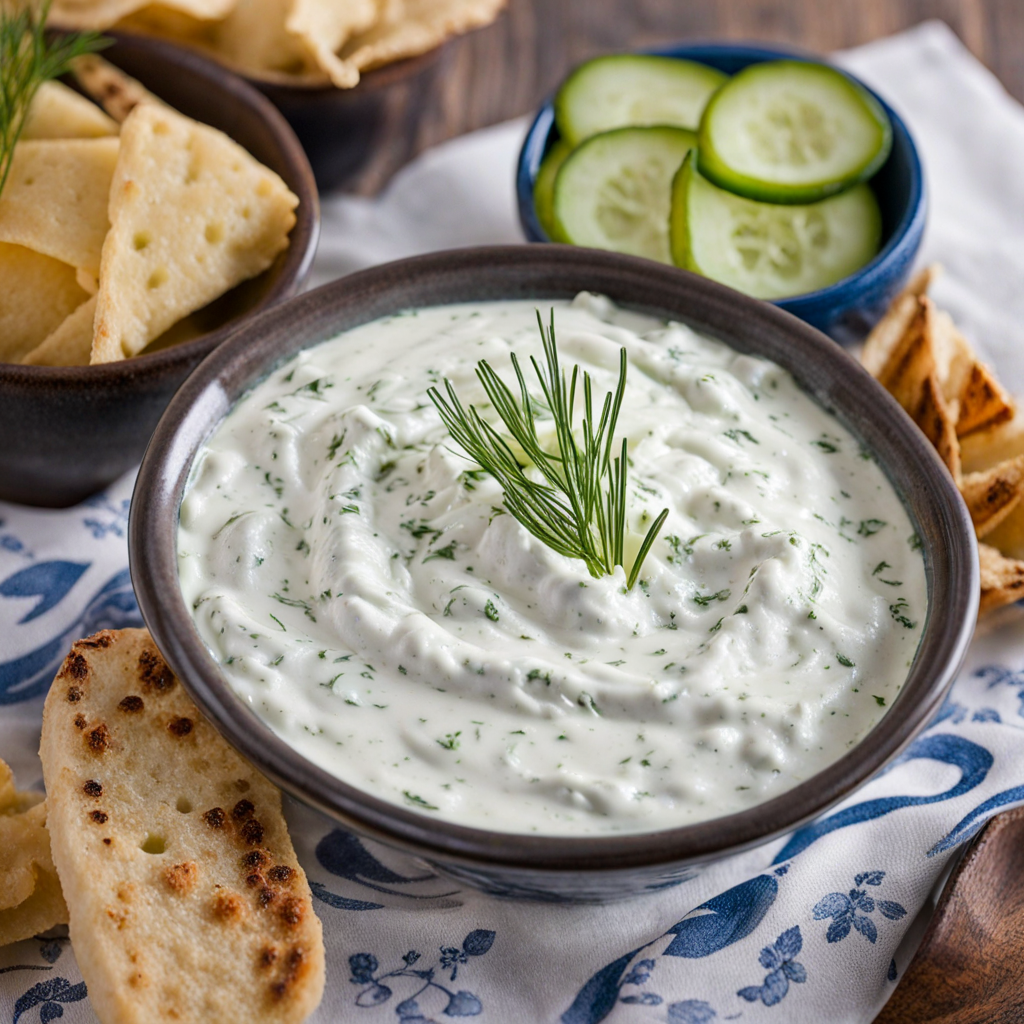Tzatziki
Tzatziki is a refreshing Greek dip that showcases the vibrant flavors of Mediterranean cuisine. At its core, this creamy condiment is made from Greek yogurt, which provides a rich and velvety texture. The yogurt is typically combined with finely grated cucumber, which adds a cool crunch and a subtle sweetness. This harmonious blend is then elevated with the addition of minced garlic, a staple in many Greek dishes, offering a pungent kick that perfectly balances the creaminess of the yogurt. A drizzle of olive oil and a sprinkle of fresh dill or mint often complete the dish, introducing herbal notes that brighten the overall flavor profile. What makes tzatziki particularly enticing is its versatility. It can be enjoyed as a dip with warm pita bread, a refreshing accompaniment to grilled meats, or even as a dressing for salads. The combination of creamy yogurt and crisp cucumber not only makes it delicious but also light and healthful, perfect for warm weather dining. Whether served at a lively Greek taverna or prepared at home, tzatziki is a dish that invites sharing and relishes the communal spirit of Greek culture. In terms of taste, tzatziki is an explosion of freshness. The tanginess of the yogurt is beautifully complemented by the coolness of the cucumber, while the garlic infuses a deeper flavor that lingers on the palate. The herbal notes of dill or mint add an aromatic quality that enhances the overall experience. Each bite transports you to the sun-drenched shores of Greece, making tzatziki not just a dish, but a celebration of flavor and culture that beckons food lovers to explore its delightful nuances.
How It Became This Dish
The Allure of Τζατζίκι: A Culinary Journey through Greek History Τζατζίκι (tzatziki) is much more than just a tangy yogurt dip; it is a culinary emblem of Greece that reflects the country’s rich history, cultural interactions, and gastronomic traditions. This creamy concoction, made primarily from strained yogurt, cucumbers, garlic, olive oil, and herbs, has captivated the palates of people for centuries. To understand its significance, we must delve into its origins, cultural importance, and evolution over time. Origins of Τζατζίκι The roots of tzatziki can be traced back to ancient civilizations in the Mediterranean region. Yogurt itself has a storied history, dating back thousands of years to the nomadic tribes of Central Asia who discovered that milk could be preserved through fermentation. As these tribes migrated westward, they brought their dairy traditions with them, influencing the culinary practices of the cultures they encountered. The word "tzatziki" likely has a Turkish origin, derived from "cacık," referring to a similar dish made with yogurt and vegetables. The Ottomans, who ruled over Greece for several centuries, played a crucial role in the culinary exchange between the two cultures. During this time, the use of yogurt as a base for dips and sauces became popular, paving the way for tzatziki to emerge as a distinct Greek variation. Cultural Significance Tzatziki is more than just a dish; it is a cultural artifact that signifies the Mediterranean lifestyle, emphasizing freshness and simplicity. In Greece, tzatziki is often served as a meze, a small dish enjoyed alongside drinks and other appetizers. It encapsulates the Greek ethos of communal dining, where meals are shared among family and friends, fostering connection and togetherness. The dish is especially prominent during festive occasions, family gatherings, and summer barbecues. On hot days, tzatziki serves as a refreshing accompaniment to grilled meats, such as souvlaki and gyros, complementing the flavors with its cool, creamy texture. Its versatility extends beyond traditional pairings, as it can also be enjoyed with pita bread, vegetables, or even as a dressing for salads. Ingredients and Regional Variations At its core, tzatziki consists of a few key ingredients: strained yogurt, cucumbers, garlic, olive oil, vinegar or lemon juice, and herbs like dill or mint. The quality of these ingredients is paramount. Greek yogurt, known for its thick and creamy consistency, is preferred for its rich flavor and high protein content. Cucumbers, typically peeled and grated, add a refreshing crunch, while garlic provides a pungent kick. Olive oil, a staple of Greek cuisine, ties the dish together with its fruity notes. While the basic composition remains consistent, regional variations of tzatziki can be found across Greece and neighboring countries. In some areas, for instance, the addition of walnuts or a hint of chili may be included for a unique twist. These variations reflect the local ingredients available and the culinary creativity of different regions, showcasing tzatziki's adaptability and enduring popularity. Historical Development As Greek cuisine evolved over the centuries, tzatziki underwent its own transformation. The Byzantine Empire greatly influenced Greek culinary practices, blending flavors from various cultures, including Middle Eastern and Persian cuisines. This cross-pollination further refined tzatziki, solidifying its place in Greek culinary tradition. During the 19th century, as Greece gained independence, tzatziki became a symbol of national identity. It was embraced by the burgeoning Greek bourgeoisie, who sought to promote traditional Greek foods as a counterpoint to foreign influences. Cookbooks began to include tzatziki recipes, ensuring that the dish would be passed down through generations. The 20th century saw tzatziki gain international popularity, particularly as Greek immigrants brought their culinary traditions to new lands. The rise of Mediterranean cuisine in the United States during the 1970s and 1980s introduced tzatziki to a broader audience, where it quickly became a favorite condiment for gyros and a staple in Mediterranean restaurants. Today, tzatziki is recognized worldwide, often appearing on menus far beyond Greece. Tzatziki in Modern Cuisine In contemporary culinary landscapes, tzatziki remains a cherished dish, but it has also evolved to meet modern dietary preferences and culinary trends. With the increasing popularity of plant-based diets, variations of tzatziki made with dairy alternatives, such as cashew or coconut yogurt, have emerged. These adaptations allow those with lactose intolerance or dietary restrictions to enjoy tzatziki without sacrificing flavor. Additionally, tzatziki has found its way into fusion cuisine, with chefs experimenting by incorporating diverse ingredients. Spicy versions with jalapeños or roasted red peppers, or even tzatziki-infused dressings for salads, showcase the dish’s versatility and adaptability in modern culinary practices. Conclusion Tzatziki is a delicious testament to Greece’s rich culinary heritage, embodying the essence of Greek culture and the Mediterranean way of life. Its origins, rooted in ancient traditions, have blossomed through centuries of cultural exchange, making it a beloved staple in Greek cuisine and beyond. As we savor tzatziki today, we partake in a timeless tradition that connects us to the past while continuing to evolve for future generations. Whether enjoyed as a dip, a sauce, or a dressing, tzatziki remains an enduring symbol of the flavors and values that define Greece.
You may like
Discover local flavors from Greece







